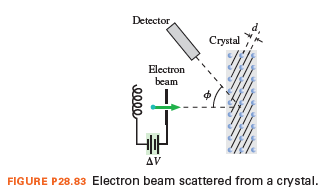Detector d. Crystal Electron beam AV FIGURE P28.83 Electron beam scattered from a crystal. 0000,
A series of experiments by Clinton Davisson and Lester Germer in the 1920s gave a clear indication of the wave nature of matter. The investigators scattered a relatively low energy electron beam from a nickel crystal. They found very strong reflections at certain angles that varied with the energy of the electron beam. The strong reflections were analogous to those observed in x-ray diffraction. The angles at which the intensity of the reflected beam peaks agreed with the Bragg condition if the electrons were
assumed to have a wavelength given by the de Broglie formula. This was conclusive experimental proof of the wave nature of the electron. Davisson and Germer used an electron beam that was directed perpendicular to the surface, as shown. They observed a particularly strong reflection, corresponding to m = 1 in the Bragg condition, at φ = 50°. At this angle, the spacing between the scattering planes was d = 0.091 nm.
The angle f in the figure is not the angle θ1 in the Bragg condition. For φ = 50°, what is θ1?
A. 25° B. 50° C. 65° D. 140°

Trending now
This is a popular solution!
Step by step
Solved in 2 steps with 2 images
